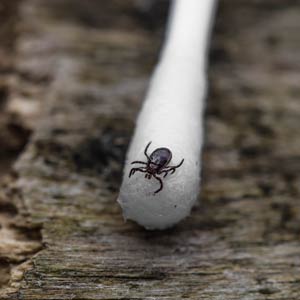 Lyme Disease Is a Serious, Summer Threat Lyme Disease Is a Serious, Summer Threat
Lyme disease is a growing concern for anyone who enjoys outdoor activities or works out of doors — especially forest preserve, conservation district and park district staff.
The Centers for Disease Control and Prevention (CDC) estimate that 300,000 new cases occur each year. Ticks bearing Lyme live in tall grass, wooded or wet marshy areas or piles of leaves, but these shade-lovers also bunk in fallen logs or even bird feeders, and hitch rides on pets and other animals. Ticks come in many varieties and can carry more than one infection, which makes proper identification and treatment tricky — but vital. According to the CDC, Lyme disease costs an average of $8,400 per case, but some can be severe enough to become a chronic condition; in 25 percent of cases, severe enough to lead to disability.
| Lyme Disease
Lyme disease is multi-staged but not every patient experiences each stage. A wide variety of symptoms are possible and differ from patient to patient — they may vary in intensity, come and go, disappear entirely or progress, making it difficult to recognize the infection.
- Early Lyme disease — Occurs within one-to-30 days of a bite. The classic “bull’s-eye” is seen in less than 20 percent of cases. Patients may also have fever, chills, muscle and joint pains, neck stiffness, headaches, fatigue and sore throat. When the rash is absent, these flu-like symptoms may be the only clue to the infection, and some patients show no symptoms in the early stage of the disease.
- Late Lyme disease — Develops weeks to years after a bite. In this stage, the infection can spread beyond the skin to other parts of the body and organs. The person may have multiple rashes along with fatigue, muscle and joint pain/generalized pain, severe headaches and stiff neck, weakness/paralysis of facial muscles and sleep and/or concentration difficulties.
- Persistent Lyme disease — Marked by persistent, recurrent and/or new symptoms of Lyme disease despite prior antibiotic therapy for the infection.
|
Terry Jennings, Executive Director of Barrington Park District, has more than academic or professional interest in raising awareness of Lyme and other tick-borne diseases. Her own diagnosis of Lyme disease makes her a dedicated advocate of awareness, education and prevention — both as the executive director of a park district and as Vice President of the Lyme Support Network.
“Ticks can be anywhere — they are as tiny as a poppy seed — and most people don’t get the telltale ‘bullseye rash’ that marks a tick bite,” she explains. “And since symptoms can take anywhere from one to 30 days to appear, it’s easy to mistake Lyme disease for other illnesses and diseases.
“It’s easily misdiagnosed and can present with flu-like symptoms, chills with or without a fever, a sore throat and even meningitis, among many other symptoms,” Jennings says. “More serious and chronic symptoms can develop later, since the disease can initially remain dormant.”
Her own experience makes Jennings committed to education and prevention at her district. “I tell staff to go into wooded areas only when necessary and to wear long-sleeve shirts and pants, a hat or bandanna, and to tuck pants into socks, so they have no openings at the bottom for a tick to enter.” Staff wears clothing treated with Permethrin, a durable insecticide that kills on contact, and the park district provides DEET as well. She readily shares information or helpful links, and this year held an information seminar to educate her staff, bringing in Park Ranger Mary Deja from McHenry County Conservation District to talk to employees about tick-borne disease and preventive measures.
 In addition, the Lyme Support Network hosts an annual Lyme Disease Walk in September at Barrington Park District’s Citizens Park that includes educational opportunities and fundraising, along with guest speakers, to encourage community outreach. “This event helps support those affected by the disease, their family and friends,” Jennings says. In addition, the Lyme Support Network hosts an annual Lyme Disease Walk in September at Barrington Park District’s Citizens Park that includes educational opportunities and fundraising, along with guest speakers, to encourage community outreach. “This event helps support those affected by the disease, their family and friends,” Jennings says.
Resources:
|

